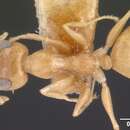en
names in breadcrumbs


Diagnosis. Worker caste polymorphic. Eyes enormously large in workers and males. Antennae geniculate, 8-segmented in worker, 10-segmented in gyne and 8-11-segmented in male. Mandible in worker and gyne with 5-10 acute teeth; mandibles in male reduced, not opposable. Posterolateral corners of the head and propodeum without spines. Fore wings with closed cells 1+2r, 3r and mcu.
Species numbers and distribution. Six extant species are known which are distributed in the Oriental tropics (Fig. 1). Three fossil species were described: Gesomyrmex hoernesi Mayr , 1868 (Baltic amber, late Eocene), G. expectans Theobald , 1937 (Kleinkembs, France, Oligocene) and G. miegi Theobald , 1937 (Haut-Rhin, France, Oligocene). The last two fossil species must be excluded from Gesomyrmex (vide infra). Five new species from middle Eocene deposits of Germany are described below.
Comments. Mayr (1868) described the genus Gesomyrmex with the unique species G hoernesi from Baltic amber from 19 workers and one male. A quarter of a century later Andre (1892) described two new extant species from Borneo. One of them was similar to fossil G. hoernesi , and he described it as Gesomyrmex chaperi . The second species differed by its large size, a more elongate head and smaller eyes, and he described it as Dimorphomyrmex janeti . Emery (1905) found in Baltic amber a specimen similar to D. janeti and described it as Dimorphomyrmex theryi . Finally Wheeler (1915) re-described G. hoernesi and D. theryi and described two new species from Baltic amber: Gesomyrmex annectens and Dimorphomyrmex mayri .
Some years later Wheeler (1929) received 18 workers, collected by L.G.K. Kalshoven in Java. All these ants were collected from the same nest, so, naturally, they belonged to the same species described as Gesomyrmex kalshoveni Wheeler . Workers from the same colony were very polymorphic. Large, medium and small workers differed by the form of the head, eye size, and mandible form. Moreover large (major) workers had characters of Dimorphomyrmex , and small (minor) and medium workers those of Gesomyrmex . As a result Wheeler designated Dimorphomyrmex as junior synonym of Gesomyrmex , and concluded that both species of Dimorphomyrmex and both species of Gesomyrmex , described from Baltic amber, really belong to one polymorphic species Gesomyrmex hoernesi Mayr .
Most extant species of Gesomyrmex are known only from the worker caste. A revision of the genus and key for determination of workers was published by Cole (1949). Only three sexuals are known: a winged gyne and a male of G luzonensis (Wheeler 1916, 1930) and a wingless gyne of G. tobiasi (Dubovikoff 2004). The last species is known only from this gyne.
Gesomyrmex is a genus of ants in the subfamily Formicinae.[1] The genus contains six extant species, known from the Indomalayan realm,[2] and nine fossil species.[3] Of the extant species, four are known only from workers (G. chaperi, G. howardi, G. kalshoveni and G. spatulatus) and two only from females (G. luzonensis and G. tobiasi).[4] The extinct species "G. expectans" and "G. miegi", formerly placed in the genus, were excluded by Dlussky et al.., 2009.
The living species are arboreal typically building nests in the twigs of trees.[3]
Gesomyrmex is a genus of ants in the subfamily Formicinae. The genus contains six extant species, known from the Indomalayan realm, and nine fossil species. Of the extant species, four are known only from workers (G. chaperi, G. howardi, G. kalshoveni and G. spatulatus) and two only from females (G. luzonensis and G. tobiasi). The extinct species "G. expectans" and "G. miegi", formerly placed in the genus, were excluded by Dlussky et al.., 2009.
The living species are arboreal typically building nests in the twigs of trees.